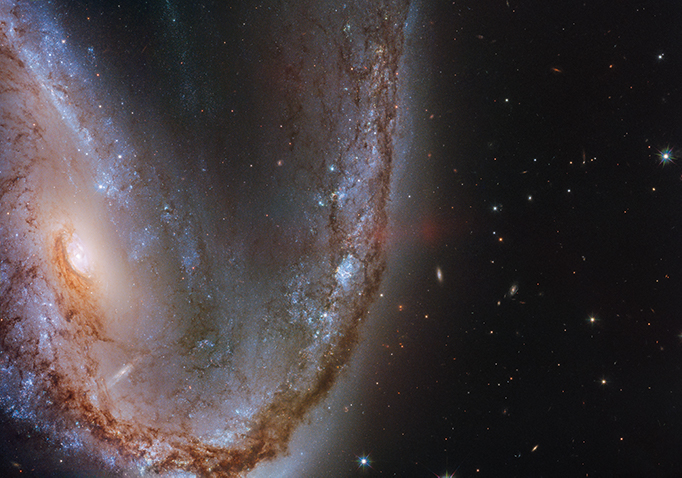A curving arm of the spiral galaxy NGC 2442 trails into extragalactic space in this glorious image from the Hubble Space Telescope.
The galaxy, which is about 50 million light years away in the Southern Hemisphere constellation of Volans, the Flying Fish, is also known as the Meathook Galaxy, thanks to the shape of its asymmetrical spiral arms, particularly its northern arm, which has been pulled out from the galaxy to form a distinctive ‘hook’ shape. We can get a sense of that in this image, with clear space between the inner part of the galaxy and the spiral arm, seemingly held rigid by a thick skeleton of dark dust. In hydrogen-alpha light, the northern spiral arm is also the most prominent, as it interacts with the extragalactic medium. There’s even a cloud of hydrogen gas, visible only at radio wavelengths, that has also been ripped from NGC 2442.

This all hints at the presence of an unseen companion galaxy that has had a close encounter with NGC 2442, the gravitational tidal forces between the two causing NGC 2442’s spiral structure to unravel. Models suggest that in a few hundred million years’ time, NGC 2442’s spiral arms will have wound themselves back in and the galaxy will have returned to normal. However, gravity won’t let it rest – NGC 2442 and its hidden companion are likely bound together now, and gravity will pull them back together for another close encounter in a few hundred million years. After a series of encounters, the two galaxies could merge in a few billion years’ time.
Is the companion galaxy really unseen though? What this image does so well is create a sense of depth, with the hazy light belonging to NGC 2442 in the foreground fading away to reveal a sky full of far more distant galaxies. And, if we look closely at NGC 2442, just below its core, then we can see another galaxy through the foreground stars. Is this the companion that has wrought all the damage to NGC 2442? Only time will tell.



